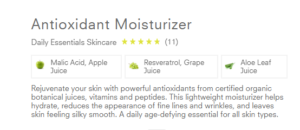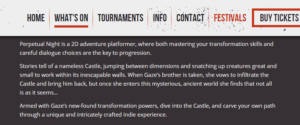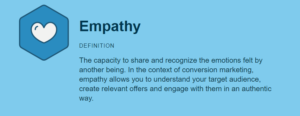How do you write your product descriptions?
I don’t mean, do you write them on your keyboard or do you write them in a notebook first.
Not that kind of “how.”
I mean, what is your process?
Do you write product descriptions rich with features?
Are they flowery or direct and to the point?
Do you even have product descriptions? (I’m not kidding, I’ve seen sites with just an image and no description…must be for mind readers.)
The best product descriptions leave your own self-interest at the door and focus on your customer’s self-interest.
Product descriptions need to do 3 things
Those two to three sentence gems need to pack a valuable punch when it comes to grabbing your customer’s attention AND getting them to do more than browse.
Each product description you have on your site needs to do three things:
- Show you understand their problem
- Empathize
- Give a solution
And, you need to write with some caring flare
Boring and direct feature rich descriptions do nothing to convert your prospect into a customer.
I found this product description from a popular “organic skin care” line that reads:

What does this description tell you about the customer? Does it touch on their current “pain”? Does it let the customer know “hey I understand what’s going on for you?”
Can you tell what brand it is?
Not really.
It’s pretty generic.
This Juice Beauty product description is feature rich but doesn’t connect at a core level with the would-be user, or offer content that builds trust and helps the prospect “see” herself in a new way.
A promise-solution driven story will.
You have a short paragraph in which to tell a story, but not your story. You have to tell the story of your prospect’s pain, empathize with their situation, and become the mentor that helps them find the solution that will change the course of their life.
No small feat right?
But it’s not as hard, or as scary, as you think.
Here’s a good example that puts its would-be user right into the story.


This description was written for Perpetual Night’s page on the Insomnia Festival site. Gamer’s want strategic, interesting AND fun…and this description captures that! (Nicely done Insomnia)
When you follow the Hero Worship Method™ you’ll easily write product descriptions that your would-be customer can see herself (or himself) woven into the story.
1. Show them you understand their problem/pain
Let me show you…
When acne-prone skin is keeping you a wallflower…
We all know that acne-prone skin can be irritating and painful, it can also make us self-conscious and emotionally vulnerable to criticism, keeping us from putting ourselves out there.
This is a story that all too many that suffer from acne feel every day.
It connects to a deeper emotion (and pain) that he/she feels.
In the Hero Worship Method™, the first step to writing copy and content that really connects with, and starts building a relationship, with your ONE reader is understanding where they are now, in their pain. Then, help them to see what their life can be like when they decide to make a change. They start to see their life in a new, and better, way.
Clayton Makepeace, one of the legends in copywriting, talks about the emotional relief benefits.
It erases your prospect’s fears and frustrations.
It eases his feelings of guilt, shame, self-doubt and feelings of inadequacy.
It soothes her nerves and ends shyness, embarrassment, prevents future humiliations.
It delivers blessed relief from loneliness, sadness or depression.
It protects them from future feelings of regret.
2. Empathize
Empathy according to Merriam-Webster – “Empathy refers to the ability to relate to another person’s pain vicariously as if one has experienced that pain themselves.”
And then there’s Brene Brown’s video that shows the power of empathy.
Empathy FUELS connection
Empathy means you can take the perspective of another person or “recognize their perspective as their truth,” stay out of judgment, recognizing emotion in other people and communicate it, and feel WITH people.
Now to incorporate empathy into your marketing in a way that is genuine and feels real to your customers.
I like Unbounce’s definition of empathy:

I’m going back to the example of acne skin to show you how to construct the product description.
We know what it’s like to be in your shoes when what you want is to confidently live life to the fullest.
When you can connect on this level when you say “hey, I get you because I’ve been there,” or you can imagine the situation and can sit next to the person in their pain and say “I’m here for you” before giving any kind of a solution.
Like in Brene Brown’s video, if I didn’t acknowledge your pain and launched into a solution, would you connect with me?
No, you’d probably feel icky and say “she’s just trying to sell me something.”
It’s not until you make that connection and let your customer know that you get her and where she is in her situation, can you proceed to offer a solution that could fit where she is and how she’s feeling.
3. Give a solution
We want to create customer experiences that matter.
We don’t want a one-and-done sale – at least I know I don’t. I want to create an experience for my customers from the first time they lay eyes on my product or service descriptions.
I want you to know I get your pain, I want to listen to what it’s like for you, and only when I understand, will I offer a solution (when you give me the queue) that may fit not only what you need now, but how it will make you feel in your life down the road.
What does a solution look like in the Hero Worship Method™?
Let’s go back to our example…
If you’re acne-prone and want to live your life confidently, but are afraid of harsh chemicals and sensitive skin reactions, you won’t try just anything, right?
Ingredients formulated with you in mind, and with age-old herbal wisdom to reduce the look of redness, soothe, calm and protect skin. My promise is that if you don’t like it, I’ll give you your money back.
Whether you’re a skin care manufacturer, an Indie game designer, or a manufacturing engineer, as a business owner, you’re not completely self-less and altruistic. You’re in business to make money.
Your product (or service) descriptions are the beginning of your business relationship. Each description needs to focus on your ONE reader, concentrate on their biggest challenge (and no, saving time and saving money are not the emotional triggers that create a deeper connection.)
Want to know more, have conversations with your customers
The best way to learn about what your customers need – so you can focus your copy and content on your ONE reader – is to talk with them directly.
A survey is a good start, but pretty impersonal.
Pick up the phone, or better yet, schedule coffee (yes, having coffee over skype counts) and get curious.
Once you have the information you need, you can create your product descriptions based on the voice-of-customer data you’ve collected from customer experiences and reviews.
You will WOW the pants off your site visitors when you write product descriptions that make your reader stop and think “Hey, they get me!”
Then, add your insight to a solution that hits home and you’ve started a long and happy customer experience.
When you build your business to consistently treat your customers with empathy and offer valuable and worthwhile solutions to what they need, you’ll see growth that wouldn’t have happened if you kept your product descriptions boring and generic.
Start a conversation by commenting below – and of course, you can share this post with your friends, family and colleagues!
Learn more about Hero Worship Marketing HERE or grab your FREE Content Hero’s Journey HERE



I like how you give examples, I found this article helpful and will be sure to share it.
Hey Sharon, I’m glad you found the examples helpful! A walk-through, a visual, or a how-to helps our readers remember and use the info we’re sharing.
This is the most helpful article ever. Guess what I’ll be doing today… reviewing me product descriptions! Thank you!
LOL Alyson – glad it’s helpful to you! Yes, the way your product descriptions are worded will make a difference in your conversions!